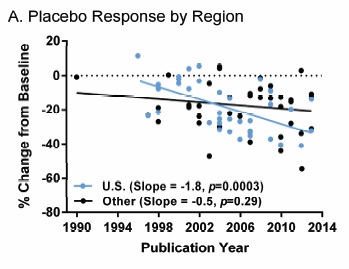Good news! According to a new study, the placebo response is getting stronger, and if this continues perhaps all our pain woes will soon be treatable with sugar pills.  But this is happening only in the United States for some reason. Why?
But this is happening only in the United States for some reason. Why?
One possible explanation is that direct-to-consumer advertising for drugs — allowed only in the United States and New Zealand — has increased people’s expectations of the benefits of drugs, creating stronger placebo effects. But Mogil’s results hint at another factor. “Our data suggest that the longer a trial is and the bigger a trial is, the bigger the placebo is going to be,” he says.
Longer, bigger US trials probably cost more, and the glamour and gloss of their presentation might indirectly enhance patients’ expectations, Mogil speculates. Some larger US trials also use contract research organizations that can employ nurses who are dedicated to the trial patients, he adds — giving patients a very different experience compared to those who take part in a small trial run by an academic lab, for instance, where research nurses may have many other responsibilities.
So good old glamor and gloss—American specialties, for sure—could be making anything in the shape of a pill more effective. On the other hand, the paper itself suggests a more prosaic possibility:
Our study results are of course potentially influenced by trends in study quality and/or publication bias….In the past, small studies were conducted. If they had a large placebo response, they did not show a positive treatment advantage and therefore they were not published. In contemporary U.S. studies, trials are typically large enough to detect positive treatment advantage despite large placebo responses, and therefore reported placebo responses appear to have increased.
So it’s possible this is all an artifact of publication bias. In the past, studies with null results for the target drug (i.e., large placebo responses) never saw the light of day. Then pharma companies got smart, and started running larger trials that would show statistically significant results no matter what. So all the studies got published, even those with large placebo responses.
You may decide which to believe. I recommend believing the glitz and glamor explanation, since glitz and glamor are bound to get ever glitzier and more glamorous over time, and are thus likely to improve your pain more. And really, who cares why your pain gets better? If it’s better drugs, fine. If it’s because pharma companies are spending lots of money on marketing, fine. Just make it go away, please.















